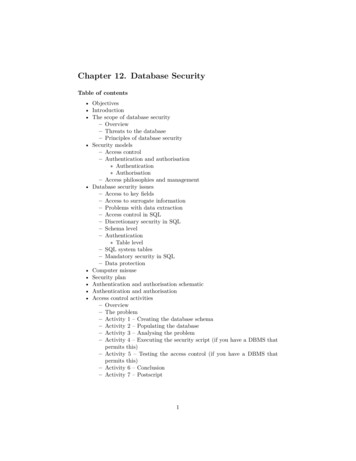
Transcription
Security Now! #852 - 01-04-22December 33rdThis week on Security Now!This week we start off the new year with a handful of Log4j updates including yet another fixfrom Apache, some false positive alarms, Alibaba in the doghouse and an underwhelmingannouncement from the US Department of Homeland Security. We note the postponement of acritical industry security conference, an interesting aspirational announcement fromDuckDuckGo's CEO, and the soon to be rising costs of cyber insurance. Then, after a bit ofmiscellany and a SpinRite update, we look at the surprising technological decision that hasforced the official creation of December 33rd.Your car might not be “Stealth” on the road but it can be invisible on the Internet!
Log4J UpdateLog4j’s 5th updateLast Tuesday the 28th, between Christmas and New Years, the Apache Software Foundation(ASF) released another batch of Log4j patches to address yet another arbitrary code executionflaw which has been discovered in Log4j and which can again be used by bad guys to run theirmalicious code on vulnerable machines. This is the 5th such security shortcoming to bediscovered in Log4j in the span of a month.And I suggest that more than anything this again highlights what happens when really smarthackers carefully examine code that really smart hackers haven't yet carefully examined. Writingcode that works is entirely different from writing code which is secure. They really are distinctand separate goals. One is easy. The other is surprisingly difficult and sets the bar far higher. It’spossible to directly “see” features in code. But it’s not possible to “see” a lack of the security inthe implementation of those features.The good news is, the CVSS severity scores do, at least, keep dropping with these successivediscoveries. None of the follow-on vulnerabilities have sported the initial eye-popping 10.0. Thislatest patched discovery is being tracked as CVE-2021-44832 with a CVSS of 6.6. All of theLog4j versions before it, from 2.0-alpha7 through 2.17.0 for Java 8 are vulnerable. The mostrecent Log4j release, which fixed this in 2.17.0, is 2.17.1.Although Apache didn't acknowledge the researcher who reported the issue, Checkmarx'ssecurity researcher Yaniv Nizry has claimed credit for reporting the vulnerability to Apache theday before, last Monday December 27th. And he’s published a detailed blog posting to back bcappender-datasource-element/Nizry said: “The complexity of this vulnerability is higher than the original CVE-2021-44228 sinceit requires the attacker to have control over the configuration. Unlike Logback, in Log4j there is afeature to load a remote configuration file or to configure the logger through the code, so anarbitrary code execution could be achieved with a MitM attack, user input ending up in avulnerable configuration variable, or modifying the config file.”The problem, of course, is the need to keep all affected libraries within the entire, sprawling, 7 to9 layer deep JAVA dependency tree updated with the latest release. This is made so much moreproblematic when Apache needs to keep updating their patches as new problems are found.Every time Apache updates Log4j, every package that uses it, or uses something that uses it, oruses something that uses something that uses it, and so on, needs to, in turn, be updated. But,of course, in every case, that can only be done after the deepest dependency using Log4j, andevery package upstream in the hierarchy is updated. It's a mess.The developer and security communities, which have been doing their best, reacted to this latestnews, which was first disclosed by Nizry's own public tweet, with an explosion of reaction traffic.One user replied: “I hope this is a joke, I hope so much. #log4j.” Another tweeted: “We areLONG past the point where the only responsible thing to do is put up a giant flashing neon signSecurity Now! #8521
that reads 'LOG4J CANNOT BE FIXED, DO NOT USE IT FOR ANYTHING.'” And Kevin Beaumontwho tweets as GossiTheDog labeled the instance another "failed Log4j disclosure in motion."During these past few weeks we’ve been treated to a ringside seat to observe everything that’swrong with the current way software is built, maintained, secured, deployed and managed. Forthe most part the system works. And what it does is truly amazing. The ability to openly andfreely build upon the work of others creates incredible economies. But it is nevertheless a brittlesystem which breaks down the moment something as ubiquitous as Log4j occurs.Microsoft's Log4j scanner triggers false positivesMeanwhile, last week, Microsoft Defender's newly — and perhaps too hastily — deployed Log4jscanner has been triggering false positive alerts which hasn't been helping anyone's nerves.Microsoft Defender for Endpoint was showing “sensor tampering” alerts linked to the company'snewly deployed Microsoft 365 Defender scanner for Log4j processes.The alerts are reportedly mainly shown on Windows Server 2016 systems and warn: “Possiblesensor tampering in memory was detected by Microsoft Defender for Endpoint” created by an“OpenHandleCollector.exe” process. And according to field reports, admins have been dealingwith this issue since at least the previous week.In response to these panic-inducing false-positives, Tomer Teller, the Principal Group PM Managerat Microsoft, Enterprise Security Posture (whatever the heck THAT is) explained that althoughthis Defender process' behavior is tagged as malicious, there's nothing to worry about sincethese are false positives. He indicated that Microsoft is currently looking into this Microsoft 365Defender issue and working on a fix that the company should soon deliver to affected systems.Tomer Teller explained: “This is part of the work we did to detect Log4J instances on disk. Theteam is analyzing why it triggers the alert (it shouldn't of course).”Exactly one week ago last Tuesday, Microsoft said that their newly deployed Log4j scanner wasrolled out with a new consolidated Microsoft 365 Defender portal Log4j dashboard for threat andvulnerability management. The new dashboard is designed to help customers identify andremediate files, software, and devices exposed to attacks exploiting Log4j vulnerabilities.To place this into perspective, this is not the first time such a thing has happened. Since October2020, Windows admins have had to deal with other Defender for Endpoint false-positives,including one that marked Office documents as Emotet malware payloads, one that showednetwork devices infected with Cobalt Strike, and another that tagged Chrome updates as PHPbackdoors. In a world where very clever bad guys have forced malware detectors into the use ofheuristic algorithms, false-positives become a real problem. The only solution is to test all newcode extensively to make sure that benign services don't raise false alarms. But the need torapidly push something out into the field to protect vulnerable enterprise users in the face of anemergency such as Log4j can make the time required for extensive testing difficult to justify.Let's just hope that amid the reports of some false alarms, the new Log4j scanner was also ableto detect unsuspected instances of Log4j on disk, as it was designed to, and that many disastershave been averted as a result.Security Now! #8522
Chinese government is annoyed with AlibabaRecall how we reported three weeks ago, that The Apache Software Foundation was firstinformed of the ultra-critical Log4j vulnerability by Alibaba in China? Well, it turns out that Chinais not happy.China's Internet regulator, the Ministry of Industry and Information Technology (MIIT), hastemporarily suspended a partnership with Alibaba Cloud which is the cloud computing subsidiaryof the e-commerce giant Alibaba Group. This 6-month suspension resulted from Alibaba's failureto promptly inform the government about the Log4j security vulnerability. [Gee. I wonder whyChina would want early access?]This suspension was disclosed by Reuters and the South China Morning Post, citing a report from21st Century Business Herald, a Chinese business-news daily newspaper. Reuters wrote:“Alibaba Cloud did not immediately report vulnerabilities in the popular, open-source loggingframework Apache Log4j2 to China's telecommunications regulator. In response, MIITsuspended a cooperative partnership with the cloud unit regarding cybersecurity threats andinformation-sharing platforms.”Log4Shell first came to light after Chen Zhaojun of the Alibaba cloud security team sent an emailalerting the Apache Software Foundation of the critical flaw on November 24. Chen added that it“has a major impact.” And just as the patch was being readied for release, details of thevulnerability were shared on a Chinese blogging platform by an unidentified actor on December8, which sent the Apache team scrambling to release the first patch two days later, on December10.One might suspect that officials within China's Ministry of Industry and Information Technologyare mostly embarrassed. MIIT said in a belated statement published on December 17th that:“This vulnerability may cause a device to be remotely controlled, which will cause serioushazards such as theft of sensitive information and device service interruption.” And the Ministryadded that it was only made aware of the flaw on December 9, 15 days after Alibaba's initialdisclosure.This pushback from MIIT occurred months after the Chinese government issued strictervulnerability disclosure regulations which mandate that software and networking vendorsaffected with critical flaws, alongside entities or individuals engaged in network product securityvulnerability discovery, report them first-hand to the government authorities mandatorily withintwo days. And last September, China followed it up by launching "cyberspace security andvulnerability professional databases" for the reporting of security vulnerabilities in networks,mobile apps, industrial control systems, smart cars, IoT devices, and other internet productsthat could be targeted by threat actors.Feeling duly chastised by the Ministry's action, according to a follow-up report from the SouthChina Morning Post, Alibaba Cloud said that it would work towards improving its riskmanagement and compliance, saying that it did not fully comprehend the severity of the flaw[uh huh ] and that it did not share the details with the government in a timely fashion.Security Now! #8523
“Hack the DHS” Bug Bounty ExpandedMeanwhile, the “Hack the DHS” bug bounty has been expanded to explicitly include Log4j flawbased attacks. The US's Homeland Security Secretary Alejandro Mayorkas recently announcedthat the DHS would broaden its new bug bounty program to solicit the discovery ofvulnerabilities in its networks resulting from exploitation of Log4j. Mayorkas tweeted:“In response to the recently discovered log4j vulnerabilities, @DHSgov is expanding the scope ofour new #HackDHS bug bounty program and including additional incentives to find and patchlog4j-related vulnerabilities in our systems. In partnership with vetted hackers, the federalgovernment will continue to secure nationwide systems and increase shared cyber resilience.”And, as we know, the CISA demanded that no one go home for Christmas until all federalagencies had addressed their own Log4j vulnerabilities. Unfortunately, as we've seen, doing thatin short order, just because someone federal bureaucrat demands it, won't make it so. Old andvulnerable versions of Log4j logging are far too deeply buried underneath existing systems to beimmediately patched overnight just because Santa was on the way.Let's hope it was a white and not a red Christmas. So far, officials at the cyber branch of theDHS have said they've seen no signs of malicious actors using the vulnerability to breach thesystems of federal departments and agencies, but they've warned that attacks utilizing the flawmight still occur. Yeah, no kidding. If attacks really haven't occurred it's only because there arestill currently too many other far more lucrative and juicy pieces of lower hanging fruit to beplucked using the Log4j hedge trimmers.However, I have to say that I'm unimpressed by what DHS is willing to pay. Mayorkas saidsecurity researchers participating in the bug bounty program would be paid anywhere from 500to 5,000 “depending upon the gravity of the vulnerability.” 500? Really? What a cheap-assgovernment! 500 isn't even worth the hassle of reporting the problem. That's ludicrous. Whenthe world is chock full of cash-rich enterprises just waiting to be ransomed, what underworldlow-life is going to waste his or her time poking around the Department of Homeland Security fora possible 500 payday?. which I assume, unlike a big ransom payment, is taxable?!I did a bit more digging into this, and I suspect that the problem is that Mayorkas or hisunderlings don't really have any idea what Log4j is.As we know, because we covered it at the time, back in 2016 the US Department of Defenseintroduced the "Hack the Pentagon" program. And after that program discovered nearly 140previously unidentified vulnerabilities on some of the department’s websites, the program wasdeclared a success and was quickly duplicated by other branches of the US military. The problemis, Log4j is not some website vulnerability. It's of an entirely different scale and class.And besides. didn't the CISA declare that Christmas would be postponed until all federalagencies had the Log4j bug expunged from their networks? Since Christmas arrived on schedulethis year, it must be that Log4j is already a non-issue within the entire federal government! So.problem solved!. Right?Your US taxpayer dollars: Hard at work? Or hardly working?Security Now! #8524
Security NewsCOVID postpones the RSA ConferenceOrganizers of the RSA Conference, one of the largest cybersecurity events of the year,announced before the end of the year that they're moving the annually scheduled Februarygathering to June over health concerns.In an email to attendees, organizers said that a recent uptick in COVID-19 cases made it difficultto hold an in-person event in the near-term. The RSA Conference was originally slated to be heldthe week of February 7 and past events have attracted tens of thousands of cybersecurityprofessionals to San Francisco’s Moscone Center and the surrounding area. As our listenersknow, it was during one of those fateful conferences that I encountered Yubico's StinaEhrensvard, whom no one had heard of at the time, standing at the top of the Moscone Centerescalators looking around for someone who would talk to her. And as a result of their brilliantconcept, the listeners of this podcast were able to play a pivotal role in Yubico's early start.In any event, for this year, Linda Gray Martin, VP of the RSA Conference wrote: “We’re extremelydisappointed to share that we’re not able to gather in person this February, but we firmly believethat with the surge in COVID-19 cases around the world, this is the responsible step to take toensure our community stays healthy and can focus on protecting our critical systems andbusinesses against ever-present cyberthreats,”Their plan is, and I hope it works out, for an in-person conference to still be held rom June 6-9.The organizers said they will contact all registered attendees, speakers, event sponsors,exhibitors, and partners regarding the postponement. And just a heads up that the healthmeasures taken for this year’s conference will in any event include requiring COVID-19 proof ofvaccination and the mandatory use of face masks for all indoor activities.DuckDuckGo continues to growWe've talked about DuckDuckGo previously. And I still have a difficult time with the name. AndI'm not sure that I want to "DuckIt!" But it's also clear that I DuckDuckGo is picking up the paceof its continued growth:Security Now! #8525
Now that 2021 has wrapped up we know how the year went for DuckDuckGo: Its privacyfocused search engine was used for more than 34.8 billion queries in 2021, which is an increaseof more than 47 percent from 2020. And given that fact that Google and Bing are known to berapaciously siphoning and tracking and doing everything in their power to extract every possiblebit of revenue from their users, DuckDuck's growth suggests that many people are becomingincreasingly comfortable with an alternative.DuckDuckGo, which initially made a name for itself being a search engine that had no interest intracking, further expanded into other products—including apps and extensions aimed atenforcing or enabling a more private online browsing experience. And now DuckDuck is planningto expand its offerings to include a browser app for desktop view/At the end of his “2021 Review” blog post, DuckDuckGo's CEO Gabriel Weinberg talked a bitabout their forthcoming desktop web browser, saying.Like we’ve done on mobile, DuckDuckGo for desktop will redefine user expectations ofeveryday online privacy. No complicated settings, no misleading warnings, no “levels” ofprivacy protection – just robust privacy protection that works by default, across search,browsing, email, and more. It's not a "privacy browser"; it's an everyday browsing app thatrespects your privacy because there's never a bad time to stop companies from spying on yoursearch and browsing history.Instead of forking Chromium or anything else, we’re building our desktop app around theOS-provided rendering engines (like on mobile), allowing us to strip away a lot of theunnecessary cruft and clutter that’s accumulated over the years in major browsers. With ourclean and simple interface combined with the beloved Fire Button from our mobile app,DuckDuckGo for desktop will be ready to become your new everyday browsing app. Comparedto Chrome, the DuckDuckGo app for desktop is cleaner, way more private, and early testshave found it significantly faster too!So, that’s interesting. I’m sure we’ll all be very curious to see how that develops.I’ve often talked about how difficult it is to build and maintain one’s own browser. These days it’slike an OS. You have to really really want to, as Google clearly does. Microsoft wanted to as well,but a web browser wasn’t central to their mission, so they wisely abandoned the sinking ship ofIE and Edge Classic in favor of a Chromium fork. Gabriel referred to forking Chromium, so thatmore obvious choice—the path taken by all non-Firefox browsers—was on DuckDuck’s radar too.But they appear to believe that they can build a lightweight web browser around the hostingOS’s native HTML rendering engine.In theory, I love the idea of what he describes as doing away with “a lot of the unnecessary cruftand clutter that’s accumulated over the years in major browsers.” But I don’t know. There aremany services that contemporary users want, expect and even need from their browsers thatmake them convenient to use. For example, what about password managers? Will DuckDuckGo’sbrowser support the industry’s emerging standard browser plug-in add-on facility? If not, can afeature-stripped desktop browser succeed in today’s world?Security Now! #8526
The cost of cyber insurance will likely be rising or perhaps terminated:Given the past several years, and the number of times we've talked about state and localgovernment agencies, including school districts, relying upon their cyberattack insurance tocover the cost of ransoms and after-attack recovery, it shouldn't surprise anyone that Wall Streetinvestors and the insurance markets are worried about the cybersecurity risks that state andlocal governments face. This is changing the economics of public sector services. and not forthe better.Offices that previously provided a limited set of local services and which never really gave muchmore than passing thought to the need for cybersecurity, are now, for the first time, findingthemselves targeted by foreign criminal or nation-state actors. And in reaction to all of thepayouts insurers have had to cough up, the rates on cybersecurity insurance—which has beenthe main line of defense for many state and local governments—has started to rise and, in somecases, to become unavailable.We know from all of our previous reporting that the bad guys are explicitly targeting entitieswhich are believed to be well insured because, as with Willie Sutton, that's where the real moneyis. As far as protecting themselves goes, for our local budget-strapped municipal and stateagencies, as always, it's a matter of funding.Omid Rahmani, the Associate Director for US Public Finance at the credit rating agency Fitch toldThe Record in an interview: “The landscape is changing quite rapidly right now, from thecybersecurity insurance and the threat landscape side, which leaves local governments in themiddle dealing with issues they traditionally haven’t had to deal with.” And literally no onebelieves that our agencies are up to the challenge they have no choice but to tackle.Last month, HillTop Securities surveyed 150 municipal bond credit analysts and specialists(excluding those who were at rating agencies). I've placed the bar graph showing the results ofone of the survey questions into the show notes:Security Now! #8527
The 13th multiple choice survey question asked was: “What is your opinion of how preparedstate and local governments and other municipal market participants currently are for CYBERATTACKS?” By far the dominant bar, at 63% of the total, was “Hardly prepared.” The runner up,which made up most of the remaining balance at 30% was “Somewhat prepared.” and theremaining 6% selected from the multiple choices was the optimistic “On their way to beingprepared.” But no one, not one of the 150 analysts surveyed, chose either the “Prepared” or“Very prepared” choices. And many of the surveyed analysts cited “cybersecurity” as a majorfactor in the current municipal bond market. What does that translate into? Higher borrowingcosts.Back in April of 2020, only 12% of those responding to a similar survey cited cybersecurityamong the top five issues affecting the municipal bond market at the time. In this updated andjust published survey, that number had risen to 29%.Which is why none of this bodes well for the future availability and/or the cost to these agenciesfor the purchase of sufficiently comprehensive cyber-attack insurance. We keep seeing thatmoney isn’t spent where there isn’t a screaming need for it to be spent. And this appears to beespecially true in I.T. which the starched-shirt C-suite executives have never really understood,nor wanted to need to understand. “Please just let all that confusing mumbo jumbo besomebody else’s problem.”Until recently, random munitical agencies were not being attacked. So not only was their truecyber-preparedness allowed to go lacking, but their insurance costs were low. However, that’snot what the future promises. At least “insurance” is something that bureaucrats canunderstand. What this means for those of us in the US, at least, is either a decrease in thequality or quantity of provided services or an increase in local taxes, since someone needs to payfor this, and taxes is where the money comes from.Sci-Fi“The Matrix Resurrections” what a disappointment!After excitedly sitting down at home with popcorn to watch the 4th installment of the franchisethat was originally a stunning visual and cerebral feast when “The Matrix” first appeared 23years ago, back 1999, I admit to having high hopes. I’m sure that after spending these past 17years together our audience knows that hope does indeed spring eternal for me. I’m anincurable optimist. But in this case, those hopes were unrealized, and the movie was shown tobe a barren money play offering us not a single new idea. Afterward, I tweeted:The Matrix Resurrections — I'm unsurprised that IMDB's viewer rating has dropped it from 6.8 to6.1 after its wide release. I was unimpressed by the seemingly endless and boring KungFu. Thewhole rationale was quite a reach. If you feel that you need to see it, don't expect much.And I just checked, the Internet Movie DataBase now pegs it at 5.7, which is not surprising.But over the holidays Lorrie and I did encounter one very pleasant surprise: Netflix’s “Don’tLook Up!” provided a wonderfully exaggerated, yet disturbingly apropos, brilliant commentary onthe many facets of creeping denialism we appear to be seeing everywhere.Security Now! #8528
SpinRiteOn the SpinRite front, I’ve become very comfortable with the project’s use of GitLab and I amvery glad I took the time to bring it online. The SpinRite development community is using it tomanage the collection of known problems that I’m whittling away at everyday.It continues to be true that the new foundation I’ve written for SpinRite is working robustly fornearly everyone. But I strongly believe it’s worthwhile to take the time, right now, to track downthe causes of any misbehavior that anyone finds.Sometimes the trouble is a bug in a chipset that is in no way SpinRite’s fault. We found anexample of that on an old AsRock motherboard. SpinRite is now using many of the features thatearly chipset was advertising, but had apparently not yet perfected. So in those cases there’snothing I can do. It only occurred when the chipset was in AHCI mode, so switching themotherboard into its legacy ATA mode, which was the BIOS’s default mode anyway, resolvedthat problem. And even when in AHCI mode, the trouble only appeared to occur the second orthird time SpinRite was run after booting. So, it probably won’t be encountered, it requiresnon-default settings to happen at all, and if it does there’s a workaround.But over this past weekend, I tracked down some really odd behavior that was only ever seen ona particular Supermicro server motherboard with a Xeon processor. It turns out that some Intelprocessors stop running their timestamp counter while the processor is halted. Servicing ahardware interrupt from a halted state can theoretically reduce a system’s interrupt responsetime, since there’s no need to wait for a current instruction to be completed. At one point in mycode I was establishing a timebase reference. So I was halting the processor before each of twosuccessive clock interrupts in order to obtain the most jitter-free reading of their interval. Now,no one else had any trouble. We have hundreds of people testing, often across multiple systems.Yet this was only seen on that one system. But now, I’m no longer halting the processor duringthat timebase establishment. It wasn’t really necessary since today’s processors run so fastrelative to the 55ms interval I was measuring. So now SpinRite runs on that system perfectly,and on untold others that would otherwise have eventually shared the same trouble. I realizethis is a different approach to developing software. But everyone here understands that I’m notjust creating software to get it shipped. I’m creating it to get it right.Security Now! #8529
December 33rdY2K22We all know that 2021 was a rough year for Microsoft's Exchange server. And, unfortunately,2022 hasn't, so far, started out much better. Or as ArsTechnica's headline read: “Microsoft fixesharebrained Y2K22 Exchange bug that disrupted email worldwide. A rookie programming errorcrashed servers because they couldn't process the year 2022.”A global mass disruption in Exchange Server 2016 and 2019 eMail delivery was the result of adate check failure which made it impossible for Microsoft's servers to accommodate the year2022. This immediately prompted the industry to label this the Y2K22 bug.So, get a load of what was lurking inside Microsoft's servers: Exchange stores dates and times as32-bit signed integers. The largest binary value that a 32-bit unsigned integer can hold is2 32-1, since we start counting from 0. And we all know that 2 32 is just shy of 4.3 billion,right? 32-bits. For example, the number of IPv4 Internet addresses, and so on.But signed integers represented in a format known as “2’s complement”, use the most significantbit as their sign bit. If that bit is set to ‘1’ the number is considered to be negative. This meansthat all positive numbers have their high-bit set to ‘0’, which reduces the maximum positivevalue that a signed 32-bit value can represent to 2 31-1.Since it’s one bit shy, 2 31-1 is going to be about half of that 4.3 billion. It's exactly 21 474 83647. Notice that the first two digits are 21? As in 2021? It turns out that Microsoft uses the firsttwo digits of an update’s version to denote the year it was released. and that version value isstored as a 32-bit signed value.That approach has a limitation that Microsoft just encountered, since the largest value you canstart a 32-bit signed integer with. is 21. You cannot start a 32-bit signed integer with 22followed by eight digits. It won't fit.Consequently, when Microsoft released version 2201010001 on New Year’s Eve, everyone'son-premises Exchange servers immediately crashed, because they were unable to figure outwhat the heck was going on. The crashes meant that Exchange was unable to process messages,which became stuck in transport queues and admins around the world — on New Years Day —were frantically trying to troubleshoot the problem, hopefully not with a hangover from overpartying the night before!That troubleshooting was not aided by the cryptic log messages that Exchange was emitting.Log Name: ApplicationSource: FIPFSLogged: 1/1/2022 1:03:42 AMEvent ID: 5300Level: ErrorComputer: server1.contoso.comDescription: The FIP-FS "Microsoft" Scan Engine failed to load. PID: 23092, Error Code: 0x80004005.Error Description: Can't convert "2201010001" to long.Security Now! #85210
Log Name: ApplicationSource: FIPFSLogged: 1/1/2022 11:47:16 AMEvent ID: 1106Level: ErrorComputer: server1.cont
The good news is, the CVSS severity scores do, at least, keep dropping with these successive discoveries. None of the follow-on vulnerabilities have sported the initial eye-popping 10.0. This latest patched discovery is being











